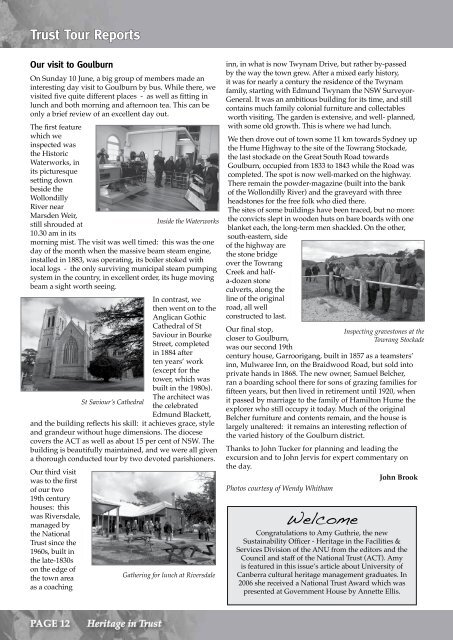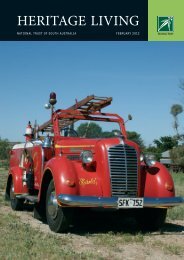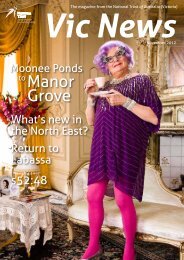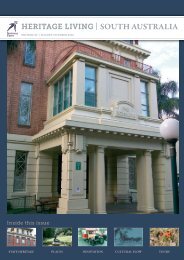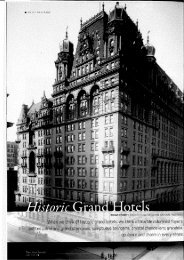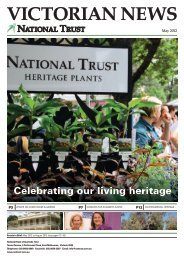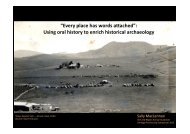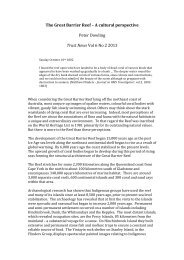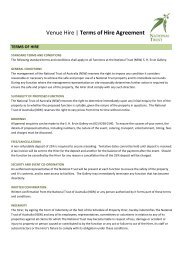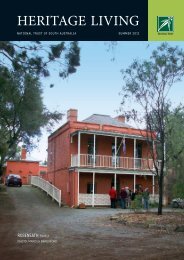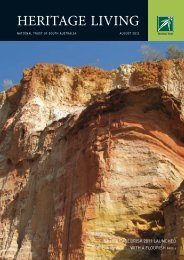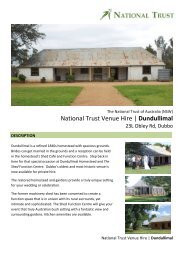Gold Creek Homestead - National Trust of Australia
Gold Creek Homestead - National Trust of Australia
Gold Creek Homestead - National Trust of Australia
- No tags were found...
You also want an ePaper? Increase the reach of your titles
YUMPU automatically turns print PDFs into web optimized ePapers that Google loves.
<strong>Trust</strong> Tour Reports<br />
Our visit to Goulburn<br />
On Sunday 10 June, a big group <strong>of</strong> members made an<br />
interesting day visit to Goulburn by bus. While there, we<br />
visited five quite different places - as well as fitting in<br />
lunch and both morning and afternoon tea. This can be<br />
only a brief review <strong>of</strong> an excellent day out.<br />
The first feature<br />
which we<br />
inspected was<br />
the Historic<br />
Waterworks, in<br />
its picturesque<br />
setting down<br />
beside the<br />
Wollondilly<br />
River near<br />
Marsden Weir,<br />
still shrouded at<br />
Inside the Waterworks<br />
10.30 am in its<br />
morning mist. The visit was well timed: this was the one<br />
day <strong>of</strong> the month when the massive beam steam engine,<br />
installed in 1883, was operating, its boiler stoked with<br />
local logs - the only surviving municipal steam pumping<br />
system in the country, in excellent order, its huge moving<br />
beam a sight worth seeing.<br />
In contrast, we<br />
then went on to the<br />
Anglican Gothic<br />
Cathedral <strong>of</strong> St<br />
Saviour in Bourke<br />
Street, completed<br />
in 1884 after<br />
ten years’ work<br />
(except for the<br />
tower, which was<br />
built in the 1980s).<br />
The architect was<br />
St Saviour’s Cathedral<br />
the celebrated<br />
Edmund Blackett,<br />
and the building reflects his skill: it achieves grace, style<br />
and grandeur without huge dimensions. The diocese<br />
covers the ACT as well as about 15 per cent <strong>of</strong> NSW. The<br />
building is beautifully maintained, and we were all given<br />
a thorough conducted tour by two devoted parishioners.<br />
Our third visit<br />
was to the first<br />
<strong>of</strong> our two<br />
19th century<br />
houses: this<br />
was Riversdale,<br />
managed by<br />
the <strong>National</strong><br />
<strong>Trust</strong> since the<br />
1960s, built in<br />
the late-1830s<br />
on the edge <strong>of</strong><br />
the town area<br />
Gathering for lunch at Riversdale<br />
as a coaching<br />
inn, in what is now Twynam Drive, but rather by-passed<br />
by the way the town grew. After a mixed early history,<br />
it was for nearly a century the residence <strong>of</strong> the Twynam<br />
family, starting with Edmund Twynam the NSW Surveyor-<br />
General. It was an ambitious building for its time, and still<br />
contains much family colonial furniture and collectables<br />
worth visiting. The garden is extensive, and well- planned,<br />
with some old growth. This is where we had lunch.<br />
We then drove out <strong>of</strong> town some 11 km towards Sydney up<br />
the Hume Highway to the site <strong>of</strong> the Towrang Stockade,<br />
the last stockade on the Great South Road towards<br />
Goulburn, occupied from 1833 to 1843 while the Road was<br />
completed. The spot is now well-marked on the highway.<br />
There remain the powder-magazine (built into the bank<br />
<strong>of</strong> the Wollondilly River) and the graveyard with three<br />
headstones for the free folk who died there.<br />
The sites <strong>of</strong> some buildings have been traced, but no more:<br />
the convicts slept in wooden huts on bare boards with one<br />
blanket each, the long-term men shackled. On the other,<br />
south-eastern, side<br />
<strong>of</strong> the highway are<br />
the stone bridge<br />
over the Towrang<br />
<strong>Creek</strong> and halfa-dozen<br />
stone<br />
culverts, along the<br />
line <strong>of</strong> the original<br />
road, all well<br />
constructed to last.<br />
Our final stop,<br />
Inspecting gravestones at the<br />
closer to Goulburn,<br />
Towrang Stockade<br />
was our second 19th<br />
century house, Garroorigang, built in 1857 as a teamsters’<br />
inn, Mulwaree Inn, on the Braidwood Road, but sold into<br />
private hands in 1868. The new owner, Samuel Belcher,<br />
ran a boarding school there for sons <strong>of</strong> grazing families for<br />
fifteen years, but then lived in retirement until 1920, when<br />
it passed by marriage to the family <strong>of</strong> Hamilton Hume the<br />
explorer who still occupy it today. Much <strong>of</strong> the original<br />
Belcher furniture and contents remain, and the house is<br />
largely unaltered: it remains an interesting reflection <strong>of</strong><br />
the varied history <strong>of</strong> the Goulburn district.<br />
Thanks to John Tucker for planning and leading the<br />
excursion and to John Jervis for expert commentary on<br />
the day.<br />
John Brook<br />
Photos courtesy <strong>of</strong> Wendy Whitham<br />
Welcome<br />
Congratulations to Amy Guthrie, the new<br />
Sustainability Officer - Heritage in the Facilities &<br />
Services Division <strong>of</strong> the ANU from the editors and the<br />
Council and staff <strong>of</strong> the <strong>National</strong> <strong>Trust</strong> (ACT). Amy<br />
is featured in this issue’s article about University <strong>of</strong><br />
Canberra cultural heritage management graduates. In<br />
2006 she received a <strong>National</strong> <strong>Trust</strong> Award which was<br />
presented at Government House by Annette Ellis.<br />
PAGE 12<br />
Heritage in <strong>Trust</strong>


